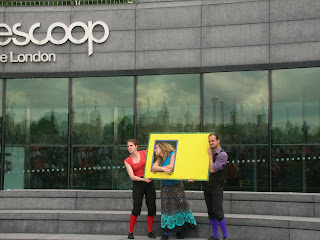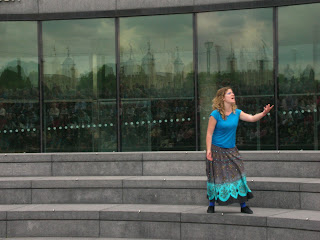Today, I went
to see a show... primarily because it was free, and you all know how I love free stuff. Actually, it turned out to be a live performance of Romeo & Juliet, brilliantly performed by the Pantaloons, who are a young acting troupe. They're going on tour for the summer, but before they do, crowds at the Scoop (right by the river, next to City Hall) get the pleasure of a free outdoor performance. I've never laughed so hard at Romeo and Juliet in my life. Except for Romeo and Juliet, each of the actors played several parts (to great success, mind you). My favorites were the nurse (high-pitched, big-boobed and squeakily hilarious) and ever-so-deaf Friar John ("I want an iron crow-bar... not a statue of a crow made out of iron, not a CD of Iron Maiden to rock out to, not iron supplements; a crow-bar! To open vaults with!" ... as Friar John putters off-stage. I love the look on his face too; it's great.
Friar Laurence: "What news from Mantua?"
Friar John: "None, I couldn't find him."
Friar Laurence: "You went to Manchester, didn't you?"
Friar John nods sadly.)
They make it genuinely funny, entertaining enough to bring children to, but there's still a significant amount of Shakespearian speech throughout the whole thing and it's clear that these guys are trained actors, as opposed to just some goofs trying to make Romeo & Juliet funny.

This fight actually took place before the show officially started. The girl in blue plays Juliet and the guy in purple was Mercutio and Friar John. For sake of ease, I shall refer to them as B (blue) and P (purple).
B: What are you doing with a custard pie?
P: It adds to the comedy.
B: There are no pies in Romeo & Juliet. You're disrespecting the legacy of a famous drama.
P: But I want to add in the pie. It's no good without the pie.
B: I told you. No pies in Romeo & Juliet.
P: But I want pie. You want to make something of it?
B: Yeah, maybe I do. You want to fight about it?
P: Yeah. I do want to fight. We'll fight in the theatrical tradition: an extremely well-choreographed fight scene where no one actually gets hurt.
B: Let's do it with cricket bats!
(fake fight begins).

This is the guy who played Romeo. Can't see it in this picture, but he's actually pretty cute. Also, very energetic. He kept running into the audience and leaping all over the stage area while he was making his speeches. You might know what I'm talking about, if you can play the videos I've attached below.

Juliet's soliloquy from her balcony window, before the famous bit, where the guy who plays Romeo actually shouted "Here comes the famous part!" before they started in on it.

A better shot of Romeo during one of his soliloquys from the audience.


The nurse (who was awesome) and Mercutio (at the time). You can catch his death scene if you watch the videos I've posted at the bottom.

Juliet and her Nurse (Anon, fair Nurse!)


I love the look on his face. His walk, his entire demeanor in the character is hilarious. I think there's a bit of it in one of the clips.
By the way, I feel obligated to say that I do not own or have any copyright to this group's performance; I was just really impressed by it and wanted to show other people how cool they were. Hopefully you will get see one of their shows for yourself if you ever get the chance. Their website is: http://www.thepantaloons.co.uk/home/
In the meantime, enjoy the clips below. They're not great, because my camera wasn't really made for recording film (also because I'm less-than-stellar behind a camera). I'm also the loon you'll hear giggling in most of the clips; you can ignore that.